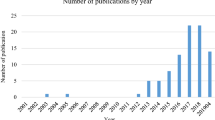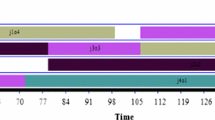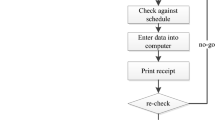Abstract
Process planning and scheduling are two of the most important functions involved in manufacturing process and they are actually interrelated; integration of the two is essential to improve the flexibility of scheduling and achieve a global improvement for the performance of a manufacturing system. In order to facilitate the optimization of process planning and scheduling simultaneously, a mathematical model for the integrated process planning and scheduling (IPPS) is established, and an improved genetic algorithm (IGA) is proposed for the problem. For the performance improvement of the algorithm, new initial selection method for process plans, new genetic representations for the scheduling plan combined with process plans and genetic operator method are developed. To verify the feasibility and performance of the proposed approach, experimental studies are conducted and comparisons are made between this approach and others with the makespan and mean flow time performance measures. The results show that the proposed approach on IPPS has achieved significant improvement in minimizing makespan and obtained good results for the mean flow time performance measure with high efficiency.
Similar content being viewed by others
References
Jain A, Jain PK, Singh IP (2006) An integrated scheme for process planning and scheduling in FMS. Int J Adv Manuf Technol 30:1111–1118
Chryssolouris G, Chan S, Cobb W (1984) Decision making on the factory floor: an integrated approach to process planning and scheduling. Robot Comput Integr Manuf 3/4:315–319
Mamalis AG, Malagardis I, Kambouris K (1996) On-line integration of a process planning module with production scheduling. Int J Adv Manuf Technol 12:330–338
Zhang J, Gao L, Chan F (2003) A holonic architecture of the concurrent integrated process planning system. J Mater Process Technol 139:267–272
Liu M, Bai L, Zhang SS (2004) Modeling integrated CAPP/PPS systems. Comput Ind Eng 46:275–283
Wang LH, Song YJ, Shen WM (2007) A novel function block based integration approach to process planning and scheduling with execution control. Int J Manuf Technol Manag 11(2):228–250
Kumar M, Rajotia S (2006) Integration of process planning and scheduling in a job shop environment. Int J Adv Manuf Technol 28:109–116
Yang YN, Parsaei HR, Leep HR (2001) A prototype of a feature-based multiple-alternative process planning system with scheduling verification. Comput Ind Eng 39:109–124
Grabowik C, Kalinowski K, Monica Z (2005) Integration of the CAD/CAPP/PPC systems. J Mater Process Technol 164–165:1358–1368
Shao XY, Li XY, Gao L, Zhang CY (2009) Integration of process planning and scheduling—a modified genetic algorithm-based approach. Comput Oper Res 36:2082–2096
Lee H, Kim SS (2001) Integration of process planning and scheduling using simulation based genetic algorithms. Int J Adv Manuf Technol 18:586–590
Lim MK, Zhang DZ (2003) A multi-agent based manufacturing control strategy for responsive manufacturing. J Mater Process Technol 139:379–384
Lim MK, Zhang DZ (2004) An integrated agent-based approach for responsive control of manufacturing resources. Comput Ind Eng 46:221–232
Wong TN, Leung CW, Mak KL, Fung RYK (2006) An agent-based negotiation approach to integrate process planning and scheduling. Int J Prod Res 44(7):1331–1351
Wong TN, Leung CW, Mak KL, Fung RYK (2006) Integrated process planning and scheduling/rescheduling—an agent-based approach. Int J Prod Res 44(18–19):3627–3655
Wong TN, Leung CW, Fung RYK (2006) Dynamic shop floor scheduling in multi-agent manufacturing system. Exp System App 31:486–494
Leung CW, Wong TN, Mak KL, Fung RYK (2010) Integrated process planning and scheduling by an agent-based ant colony optimization. Comput Ind Eng 59:166–180
Shukla SK, Tiwari MK, Son YJ (2008) Bidding-based multi-agent system for integrated process planning and scheduling a data mining and hybrid tabu-SA algorithm-oriented approach. Int J Adv Manuf Technol 38:163–175
Li XY, Zhang CY, Gao L, Li WD, Shao XY (2010) An agent-based approach for integrated process planning and scheduling. Exp System App 37:1256–1264
Weintraub A, Cormier D, Hodgson T, King R, Wilson J, Zozom A (1999) Scheduling with alternatives: a link between process planning and scheduling. IIE Trans 31:1093–1102
Tan W, Khoshnevis B (2004) A linearized polynomial mixed integer programming model for the integration of process planning and scheduling. J Intell Manuf 15:593–605
Li WD, McMahon CA (2007) A simulated annealing-based optimization approach for integrated process planning and scheduling. Intl J Comput Integr Manuf 20(1):80–95
Li XY, Shao XY, Gao L, Qian WR (2010) An effective hybrid algorithm for integrated process planning and scheduling. Int J Prod Eco 126:289–298
Li XY, Shao XY, Zhang CY (2010) Mathematical modeling and evolutionary algorithm-based approach for integrated process planning and scheduling. Comput Ope Res 37:656–667
Moon C, Kim J, Hur S (2002) Integrated process planning and scheduling with minimizing total tardiness in multi-plants supply chain. Comput Ind Eng 43:331–349
Moon C, Seo Y (2005) Evolutionary algorithm for advanced process planning and scheduling in a multi-plant. Comput Integ Eng 48:311–325
Moon C, Lee YH, Jeong CS, Yun YS (2008) Integrated process planning and scheduling in a supply chain. Comput Ind Eng 54:1048–1061
Kim YK, Park K, Ko J (2003) A symbiotic evolutionary algorithm for the integration of process planning and job shop scheduling. Comput Ope Res 30:1151–1171
Qiao LH, Kao ST, Zhang YZ (2011) Manufacturing process modeling using process specification language. Int J Adv Manuf Technol. doi:10.1007/s00170-010-3115-3
Lee DY, Dicesare F (1994) FMS scheduling using Petri nets and heuristic search. IEEE Transa Robot Autom 10(2):123–132
Yang Z, Qiao L, Jiang L (1998) Improving the performances of part dispatching based on multiple process plans using graph theory. Int J Prod Res 36(7):1987–2003
Ho YC, Moodie CL (1996) Solving cell formation problems in a manufacturing environment with flexible processing and routing capabilities. Int J Prod Res 34:2901–2923
Bierwirth C, Mattfeld DC (1999) Production scheduling and rescheduling with genetic algorithms. Evol Comput 7:1–17
Leung CW, Wong TN, Mak KL, Fung RYK (2006) Integrating process planning and scheduling by an agent-based ant colony system. In Proceedings of the 36th International Conference on Computers and Industrial Engineering 587–596
Chryssolouris G, Pierce JE, Dicke K (1992) A decision-making approach to the operation of flexible manufacturing systems. Int J Flex Manuf Sys 3(4):309–330
Jain AK, Elmaraghy HA (1997) Production scheduling/rescheduling in flexible manufacturing. Int J Prod Res 35:281–309
Sundaram RM, Fu SS (1988) Process planning and scheduling. Comput Ind Eng 15:296–307
Palmer GJ (1996) A simulated annealing approach to integrated production scheduling. J Intell Manuf 7:163–176
Kim YK (2003) A set of data for the integration of process planning and job shop scheduling. Available at: http://syslab.chonnam.ac.kr/links/data-pp&s.doc. Accessed 4 Oct 2010
Author information
Authors and Affiliations
Corresponding author
Rights and permissions
About this article
Cite this article
Lihong, Q., Shengping, L. An improved genetic algorithm for integrated process planning and scheduling. Int J Adv Manuf Technol 58, 727–740 (2012). https://doi.org/10.1007/s00170-011-3409-0
Received:
Accepted:
Published:
Issue Date:
DOI: https://doi.org/10.1007/s00170-011-3409-0




